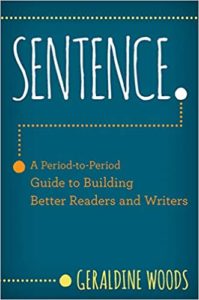Sentences to Get Kids Reading and Writing
Sentence. A Period-to-Period Guide to Building Better Readers and Writers
By Geraldine Woods
(W. W. Norton, 2021 – Learn more)
Reviewed by Rebecca Crockett
I picked up Sentence. A Period-to-Period Guide to Building Better Readers and Writers thinking it would build on the ideas of using mentor sentences for grammar – something I was familiar with from reading Jeff Anderson’s work.
What I found upon reading wasn’t really a grammar book at all, although it has elements of grammar included, but instead a book on using selected sentences to teach the acts of reading and writing themselves.
Part I: Instructional strategies

Written in a first-person conversational style (a quality I prefer in my professional development books) Sentence feels like getting advice from a respected colleague.
All of Woods’ ideas start with examining the sentences, proceed to students becoming detectives in discovering why the author in question made the choices they did, and end with optional writing and research options for student practice.
As I strive for a more student-centered classroom, I respect her focus on student observations and conversations around these guiding sentences as a jumping-off point to analyzing and ultimately creating sentences themselves.
Part II: A “buffet rather than a five-course meal”
I will admit that I didn’t read Part II “Sentence Elements to Teach” in its entirety (though it is heavily highlighted and flagged where I plan to implement lessons with my students).
This part is described by the author herself as a “buffet rather than a five-course meal” where “you can select just what your class needs and your schedule permits” (xvi).
With sub-sections devoted to structure, diction, sound, connections, and comparisons, Woods has grouped her sentence types in a format that is easy to navigate so teachers can utilize those types that their standards require or students show a need for.
In a few cases, she has coined her own terminology for sentence constructions students should notice and be able to imitate for their own uses, such as pocket structure to describe a sentence “containing two expressions of the same idea” (64).
It is evident that Woods is a master of her craft given the depth and sequencing she is able to provide. Each element described, whether parallel structure or synesthesia, contains optional introduction activities and a lesson plan based upon focus sentences (that includes both brief and extended context for sentences depending upon the teacher’s purpose), as well as specific questions to ask to deepen student understanding.
That would be enough to make this an oft-referenced book in the classroom, but Woods doesn’t stop there, instead continuing with supplemental material based upon different focus sentences, but which includes how to incorporate the teaching of specific grammatical elements and rhetoric! She ends by offering writing options and sometimes research pieces as well.
I appreciated that the appendices allow for searching by theme, genre, and alphabetically by author/text, but as a middle and high school teacher, I especially loved that she asterisks the texts she successfully used with younger students.
As I outlined my teaching year, I made space for Sentence. A Period-to-Period Guide to Building Better Readers and Writers. Knowing that I can have a stockpile of quality sentences that students can easily gain access to while working on increasingly deeper reading, writing, and yes, grammar skills, is reassuring.
I value the work Geraldine Woods has done in creating Sentence and the expertise she provides to teachers less experienced with this method of teaching.
Rebecca Crockett is currently an English teacher for grades seven and nine in north central Idaho. A fourteen-year teaching veteran, she has taught at both the elementary and secondary levels. She is an avid reader, curriculum planner, and sometimes writer for her own enjoyment and to practice what she preaches. Summers find her devouring professional development books to improve her craft; thus she has written many reviews for MiddleWeb.






























